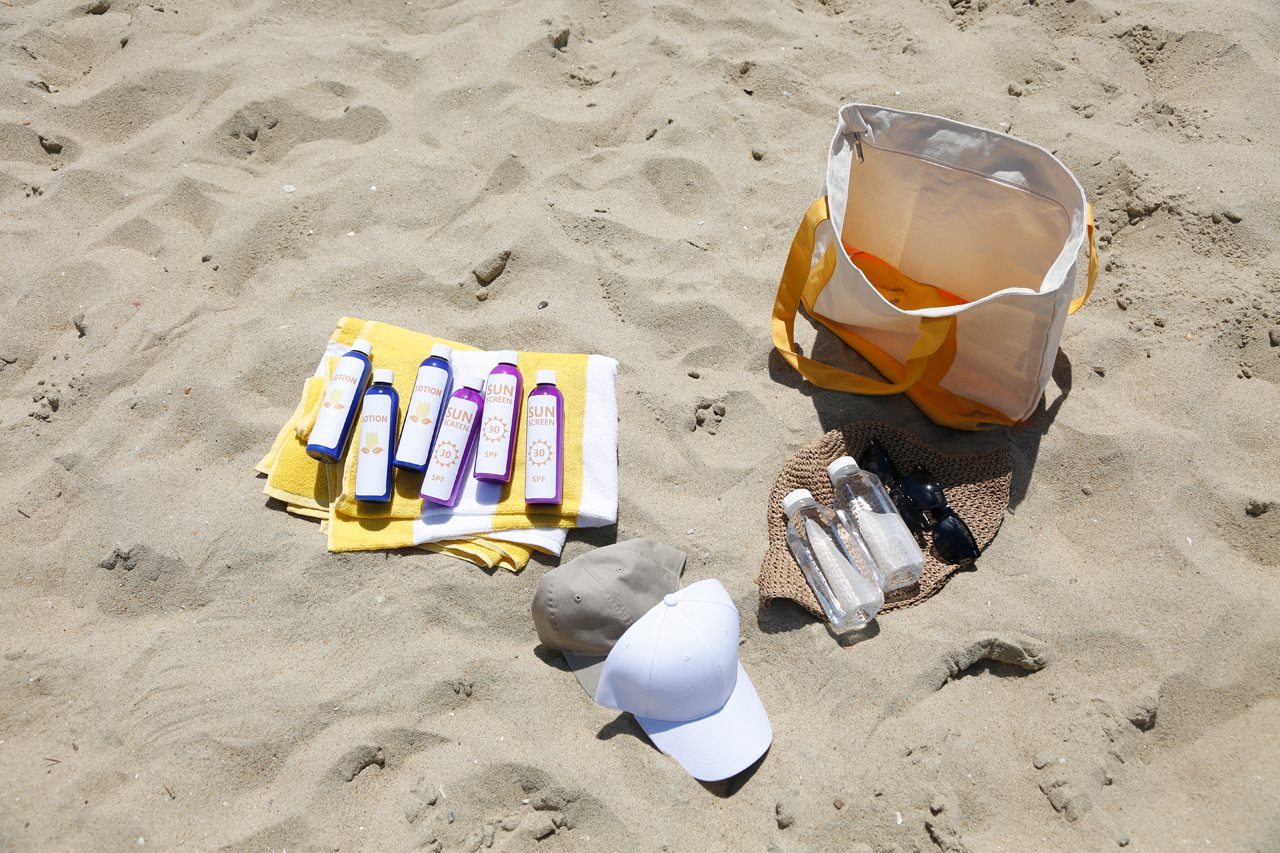2022-09-22T15:31:00
(BPT) – The beach is an ideal place to make memories with friends and family, the perfect way to unwind, relax and soak in the sun. But for those living with uncontrolled moderate-to-severe atopic dermatitis (AD), the most common form of eczema, going to the beach can get complicated when the heat, saltwater and sand can worsen the persistent itch and lesions.
The Now Me: Beach Mode, a program by Sanofi and Regeneron, aims to help empower those living with moderate-to-severe eczema to feel comfortable with their own skin. As part of the program, two teams of patients and caregivers took on common beach day challenges inspired by their own experiences living with eczema. Working together, they activated their “Beach Mode” and found comfort in connecting with each other to have a successful beach day.
If you or your loved one are living with moderate-to-severe eczema, here are some tips to help you enjoy a day at the beach.
1. Set Up Shade and Cool Off
Too much heat exposure can exacerbate eczema symptoms – making dry skin, itching and irritation worse. Setting up a shady area to stay protected from the heat is an important part of a day at the beach for many living with moderate-to-severe eczema.
Take it from Adante, one of the participants in the Now Me: Beach Mode challenge. “Beach umbrellas can be key to helping me feel comfortable if it’s too hot,” he noted. “It can be hard to avoid the sun unless you find or create your own shade.”
2. Pack the Right Items for You
Preparation is key when headed to the beach. In addition to the typical supplies like towels and sunscreen, people with moderate-to-severe eczema may also need to bring things like moisturizer to help with dryness, and fresh water to gently rinse off sand and cool off.
Arsalan, who has moderate-to-severe eczema, got packing down to a science during The Now Me: Beach Mode challenges: “You have to pack a very large amount of sunscreen, and make sure it’s the right kind of sunscreen for the sake of sensitivity,” he said. “I always try to bring a lot of lotion to prevent my skin from drying out, and I bring towels to make sure that the sand doesn’t aggravate my skin.”
3. Wear Protective Clothing
Some people may find it beneficial to bring extra clothing made of breathable fabric to the beach to help prevent sunburn and protect skin. Long-sleeved rash guards, hats, extra towels and sunglasses are a must have for many beachgoers with eczema.
Arsalan knows from personal experience how wearing clothing that helps protect your skin can help make your day at the beach. “Bringing sunglasses, hats and extra clothing to the beach can make the experience more comfortable for you,” he explained. “Find what works for you and stick with it!”
4. Finding the Right Treatment Plan for You
If you or your loved one are experiencing symptoms of uncontrolled moderate-to-severe eczema, it’s important to talk to your doctor to find the right treatment plan for you. Treatments for people with uncontrolled moderate-to-severe eczema range from over-the-counter and prescription topical therapies to systemic therapies, including prescription oral steroids, immunosuppressants and biologic treatments such as Dupixent, also known as dupilumab.
Dupixent is a biologic treatment for people ages 6 months and older with moderate-to-severe atopic dermatitis that is not well-controlled with topical prescription therapies, or for those who cannot use topical therapies.
Dupixent helps block a key source of inflammation deep beneath the skin to help heal the skin from within, leading to noticeably less itch and clearer skin. It is the only biologic medicine for uncontrolled moderate-to-severe atopic dermatitis approved by the FDA for children as young as six months to adulthood.
In two clinical trials, almost four times more adult patients taking Dupixent saw clear or almost clear skin at 16 weeks compared with those not taking Dupixent (37% taking Dupixent vs 9% not taking Dupixent). Adult patients also experienced significant reduction in itch at 16 weeks when treated with Dupixent (38% vs 11% in those not taking Dupixent).
People shouldn’t use Dupixent if they are allergic to it or its ingredients. The most common side effects in patients with atopic dermatitis include injection site reactions, eye and eyelid inflammation, including redness, swelling, and itching, sometimes with blurred vision, cold sores in your mouth or on your lips, and high count of a certain white blood cell (eosinophilia). Serious side effects include allergic reactions that can sometimes be severe, eye problems and joint aches and pain. Please see full indication and Important Safety Information below along with links to the full Prescribing Information and Patient Information.
Visit Dupixent.com to learn more about Dupixent.
As Arsalan says, if you or your loved ones are struggling with uncontrolled moderate-to-severe eczema, “please don’t lose hope.” Do your own research, talk to your doctor, and empower yourself with strategies that work for you or your loved one, so you can activate your “Beach Mode” this summer.
Visit TheNowMe.com to learn about the program and watch inspiring stories of people living with moderate-to-severe eczema and their “Beach Mode.”
IMPORTANT SAFETY INFORMATION & INDICATION
Do not use if you are allergic to dupilumab or to any of the ingredients in DUPIXENT®.
Before using DUPIXENT, tell your healthcare provider about all your medical conditions, including if you:
- have eye problems.
- have a parasitic (helminth) infection.
- are scheduled to receive any vaccinations. You should not receive a “live vaccine” right before and during treatment with DUPIXENT.
- are pregnant or plan to become pregnant. It is not known whether DUPIXENT will harm your unborn baby.
- are breastfeeding or plan to breastfeed. It is not known whether DUPIXENT passes into your breast milk.
Tell your healthcare provider about all the medicines you take, including prescription and over-the- counter medicines, vitamins and herbal supplements.
Especially tell your healthcare provider if you are taking oral, topical or inhaled corticosteroid medicines or if you have atopic dermatitis and asthma and use an asthma medicine. Do not change or stop your corticosteroid medicine or other asthma medicine without talking to your healthcare provider. This may cause other symptoms that were controlled by the corticosteroid medicine or other asthma medicine to come back.
DUPIXENT can cause serious side effects, including:
- Allergic reactions. DUPIXENT can cause allergic reactions that can sometimes be severe. Stop using DUPIXENT and tell your healthcare provider or get emergency help right away if you get any of the following signs or symptoms: breathing problems or wheezing, swelling of the face, lips, mouth, tongue, or throat, fainting, dizziness, feeling lightheaded, fast pulse, fever, hives, joint pain, general ill feeling, itching, skin rash, swollen lymph nodes, nausea or vomiting, or cramps in your stomach-area.
- Eye problems. Tell your healthcare provider if you have any new or worsening eye problems, including eye pain or changes in vision, such as blurred vision. Your healthcare provider may send you to an ophthalmologist for an eye exam if needed.
- Joint aches and pain. Some people who use DUPIXENT have had trouble walking or moving due to their joint symptoms, and in some cases needed to be hospitalized. Tell your healthcare provider about any new or worsening joint symptoms. Your healthcare provider may stop DUPIXENT if you develop joint symptoms.
The most common side effects in patients with atopic dermatitis include injection site reactions, eye and eyelid inflammation, including redness, swelling, and itching, sometimes with blurred vision, cold sores in your mouth or on your lips, and high count of a certain white blood cell (eosinophilia).
Tell your healthcare provider if you have any side effect that bothers you or that does not go away. These are not all the possible side effects of DUPIXENT. Call your doctor for medical advice about side effects. You are encouraged to report negative side effects of prescription drugs to the FDA. Visit www.fda.gov/medwatch, or call 1-800-FDA-1088.
Use DUPIXENT exactly as prescribed by your healthcare provider. It’s an injection given under the skin (subcutaneous injection). Your healthcare provider will decide if you or your caregiver can inject DUPIXENT. Do not try to prepare and inject DUPIXENT until you or your caregiver have been trained by your healthcare provider. In children 12 years of age and older, it’s recommended DUPIXENT be administered by or under supervision of an adult. In children under 12 years of age, DUPIXENT should be given by a caregiver.
Please see full Prescribing Information including Patient Information.
INDICATION
DUPIXENT is a prescription medicine used to treat adults and children 6 months of age and older with moderate-to-severe atopic dermatitis (eczema) that is not well controlled with prescription therapies used on the skin (topical), or who cannot use topical therapies. DUPIXENT can be used with or without topical corticosteroids. It is not known if DUPIXENT is safe and effective in children with atopic dermatitis under 6 months of age.
© 2022 Sanofi and Regeneron Pharmaceuticals, Inc.
All Rights Reserved. DUPIXENT® is a registered trademark of Sanofi Biotechnology.
DUP.22.07.0249
















